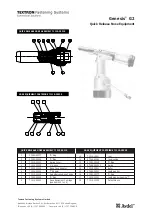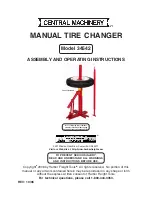
8843799
5/16 in. Pistol Grip Air Punch and Flange Tool
V1.0
6
For technical questions call 1-800-665-8685
4.
Check the manufacturer’s maximum pressure rating for air tools and
accessories. Compressor outlet pressure must be regulated to never
exceed the maximum pressure rating of the tool (see Specifications).
Exceeding the maximum PSI rating can create a bursting hazard,
causing injury and property damage.
a.
Never connect to an air source that is capable of exceeding 200 PSI.
b. Do not exceed the maximum working pressure of 90 PSI / 6.3 bar.
5.
Attach all accessories properly to the tool before connecting the air
supply. A loose accessory may detach or break during operation.
6. Never use oxygen, combustible gas or any other bottled gas as a
power source. Any power source other than an air compressor could
cause an explosion and serious personal injury.
7.
Turn OFF the valve and discharge any remaining air pressure after each
use or before adjusting the tool.
8. Do not leave the air tool unattended with its compressed air supply on.
Turn off the compressed air supply and bleed the air tool of any
remaining compressed air before leaving the air tool unattended.
9.
Serious injury may occur from loose debris being propelled at high speeds
from the compressed air stream. Always wear OSHA approved safety
glasses to protect the eyes during operation of the air compressor.
10. Always turn off the air compressor and drain tank pressure completely
before attempting maintenance or attaching air tools. Release pressure
slowly from the system.
11. Do not try to punch or flange material thicker than 16 gauge.
AIR HOSE PRECAUTIONS
1.
Inspect the tool's air hose for cracks, fraying or other faults before
each use. Discontinue use if the air hose is damaged or hissing is heard
from the air hose or couplers. Replace the defective air hose.
2. Do not allow people, mobile equipment or vehicles to pass over the
unprotected air hose. Position the air hose away from high traffic
areas, in a reinforced conduit or place planks on both sides of the air
hose to create a protective trench.
3.
Prevent damage to the air hose by observing the following:
a.
Never carry the tool by the air hose.
b. Keep the air hose behind the tool and out of the tool's work path.







































